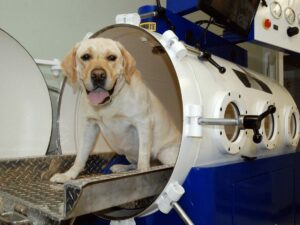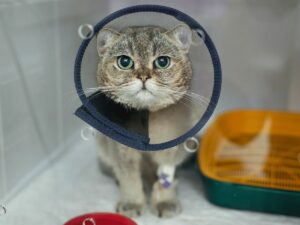Ever considered the power of oxygen in healing our animal companions? The answer lies within the capabilities of a veterinary hyperbaric chamber.
With years of expertise in hyperbaric medicine, our insights offer a reliable source for understanding this advanced therapy.
Veterinary hyperbaric therapy represents a breakthrough in animal care. It’s an innovative approach that leverages the simple element of oxygen to achieve remarkable recovery results.
In this guide, you’ll learn about the fundamentals of hyperbaric therapy for animals, its benefits, and the diverse applications that make it a game-changer in veterinary medicine.
Uncover hyperbaric therapy in veterinary care!
Veterinary hyperbaric chambers leverage the powerful benefits of oxygen under pressure, providing a regulated setting for pets to undergo hyperbaric oxygen therapy (HBOT). This approach offers pet owners new solutions for their animals’ recovery. The integration of HBOT in veterinary care reflects a commitment to innovative solutions that significantly enhance animal well-being.
Highlighting the importance of this technology, Exactitude Consultancy predicts the global market for hyperbaric oxygen therapy devices will see a Compound Annual Growth Rate (CAGR) of 8.36% by 2030. This anticipated growth indicates a rising adoption and value of HBOT in improving pet health, emphasizing its role in advancing veterinary medicine.
Following our dive into understanding hyperbaric chambers for veterinary use, it’s clear these tools offer a significant advantage in treating pets. Here are the key benefits that hyperbaric oxygen therapy (HBOT) provides.
One of the most compelling advantages of HBOT is its ability to speed up the healing process. For instance, by delivering a higher concentration of oxygen to the body’s tissues, it promotes faster recovery from wounds, infections, and other conditions. This increased oxygen supply helps fight bacteria and stimulates the release of substances called growth factors and stem cells, which promote healing.
Here’s the bottom line: HBOT significantly reduces inflammation and, as a result, can decrease pain. For pets suffering from inflammatory conditions or injuries, this therapy offers a comforting relief that is both effective and non-invasive. The reduction in swelling not only makes the pet more comfortable but also contributes to the healing process by improving blood flow to the affected areas.
And the best part is, the applications of HBOT are incredibly versatile. Whether it’s a snake with an infection, a dog recovering from surgery, or a cat with a slow-healing wound, HBOT can be adapted to treat a wide range of conditions. This flexibility makes it an invaluable tool in the veterinary field, offering hope and improved outcomes for conditions that might otherwise have limited treatment options.
After exploring the remarkable benefits of hyperbaric oxygen therapy for pets, it’s evident how transformative this treatment can be. Here are the different types of chambers available, each designed to cater to various needs and sizes of animals.
These chambers are designed for individual animals, allowing for a focused and controlled environment. Oxygen-ark’s monoplace chambers are perfect for smaller pets, such as dogs, cats, and rabbits, providing them with the precise oxygen levels needed for their treatment. The intimate setting ensures that veterinarians can closely monitor the pet’s response to the therapy, making adjustments as necessary for optimal outcomes.

As the name suggests, multiplace chambers can accommodate multiple animals simultaneously, making them ideal for larger veterinary practices or facilities treating numerous pets. These chambers are also suitable for larger animals, offering the same high levels of oxygen in a spacious environment. This versatility ensures that every pet receives the benefits of HBOT, regardless of size or condition.
There are also portable hyperbaric chambers available for veterinary use. These units offer flexibility and convenience, allowing for on-site treatments at animal hospitals, clinics, or even in emergency situations. While smaller than stationary chambers, portable models provide the same therapeutic benefits, ensuring pets receive the care they need, whenever and wherever it’s required.

Reflecting on the various types of veterinary hyperbaric chambers available, the flexibility and adaptability of HBOT make it suitable for a wide range of conditions. Here are some of the key veterinary conditions where HBOT has shown to be particularly beneficial.
HBOT accelerates the healing process of wounds, including those that are slow to heal or infected. By increasing oxygen concentration in the bloodstream, it enhances the body’s natural ability to heal, reducing recovery time. This is particularly important for animals that may not tolerate traditional wound care methods well, providing a less stressful alternative for both pets and their owners.

For infections that struggle to heal with standard treatments, HBOT can be a game-changer. For instance, it boosts the body’s immune response and helps fight off bacteria, including those resistant to antibiotics. This therapy is especially valuable for treating deep-seated, difficult-to-eradicate infections without the side effects associated with long-term antibiotic use.
HBOT has shown promise in treating pets with neurological conditions, including those suffering from stroke or traumatic brain injuries. The therapy can reduce swelling and promote recovery of affected tissues, improving outcomes for animals with these challenging conditions. It’s a ray of hope for pets facing neurological difficulties, offering a path to potentially improved functionality and quality of life.
HBOT can significantly enhance recovery following surgery. Oxygen-ark suggests that by reducing inflammation and swelling, it helps animals recuperate more quickly, getting them back on their feet sooner. This is particularly beneficial for surgeries involving critical areas such as the spine or brain, where accelerated healing can make a significant difference in the pet’s recovery trajectory.
After exploring the variety of conditions that hyperbaric oxygen therapy can treat, it’s crucial to recognize the safety of pets. Here are essential safety protocols to ensure pets are well-cared for in hyperbaric chambers:
Adhering to strict safety protocols significantly minimizes risks associated with hyperbaric oxygen therapy (HBOT) in pets. Here are the most common ones and how they are managed to ensure the safety and comfort of our animal companions.
Just as humans can experience ear discomfort due to changes in pressure, pets may also face similar issues during HBOT sessions. This discomfort is typically managed by gradually adjusting the pressure to allow pets time to acclimatize. Additionally, veterinarians might demonstrate specific techniques to pet owners to help their animals equalize ear pressure before and after treatment.
Although rare, prolonged exposure to high concentrations of oxygen can lead to oxygen toxicity. This condition can affect the lungs and central nervous system. To prevent this, the duration and frequency of HBOT sessions are carefully calculated based on the pet’s specific needs and condition. Monitoring during therapy is rigorous, with any signs of distress being promptly addressed by adjusting the therapy parameters.
Here’s a table about the considerations and management of oxygen toxicity in hyperbaric oxygen therapy (HBOT):
| Aspect | Consideration | Management Strategy |
| Preventive Measures | Rigorous monitoring and adjusting therapy parameters to mitigate risks. | Continuous observation for any signs of distress during therapy sessions. |
| Patient Safety | Immediate response to any distress signs to prevent adverse effects. | Quick modification of therapy parameters if signs of toxicity arise. |
| Therapy Customization | Customizing therapy based on individual conditions and tolerance to oxygen. | Each therapy session is designed to maximize benefit and minimize risk. |
| Veterinary Oversight | Professional supervision ensures that the therapy is conducted safely. | Veterinary professionals oversee the session to ensure optimal safety. |
Some animals may initially react to the confined space of the chamber with anxiety or claustrophobia. Techniques such as positive reinforcement, gentle acclimatization sessions, and, if needed, mild sedation (under strict veterinary supervision) can help reduce stress and make the experience more comfortable for the pet.
After exploring the potential side effects and management strategies of hyperbaric oxygen therapy (HBOT) for pets, it’s clear there are technical aspects to weigh before proceeding. Here are crucial technical considerations to factor in.
The effectiveness of HBOT hinges on the precise settings of pressure and oxygen concentration within the chamber. Typically, treatments are administered at pressures between 1.5 to 3 times the normal atmospheric pressure, with an oxygen concentration of near 100%. Understanding these settings helps gauge the intensity of treatment the pet will undergo, ensuring it aligns with their specific medical needs.
The length and number of HBOT sessions can vary widely depending on the condition being treated. Sessions usually last between 1 to 2 hours and may be required daily over a certain period or intermittently. It’s important to discuss with the vet the proposed treatment plan, including the total number of sessions anticipated and their distribution over time, to understand the commitment required.
Veterinary hyperbaric chambers come in different sizes and types, from monoplace units designed for individual animals to larger multiplace units that can accommodate multiple pets or larger breeds. The choice of chamber can affect the comfort and movement of the pet during treatment, as well as the overall effectiveness of the therapy.
Utilizing the simple yet profound power of oxygen under pressure, opens new horizons for medical facilities dedicated to animal care. From speeding up the healing of wounds to fighting off stubborn infections, the benefits of veterinary hyperbaric therapy are extensive and deeply impactful.
Whether you are part of a veterinary clinic, or any institution dedicated to the care and recovery of animals, exploring the possibilities with Oxygen-ark could be invaluable. Contact us today to learn more.
Get in touch with us and unlock your full well-being potential!
The OxygenArk team is here to assist you every step of the way.